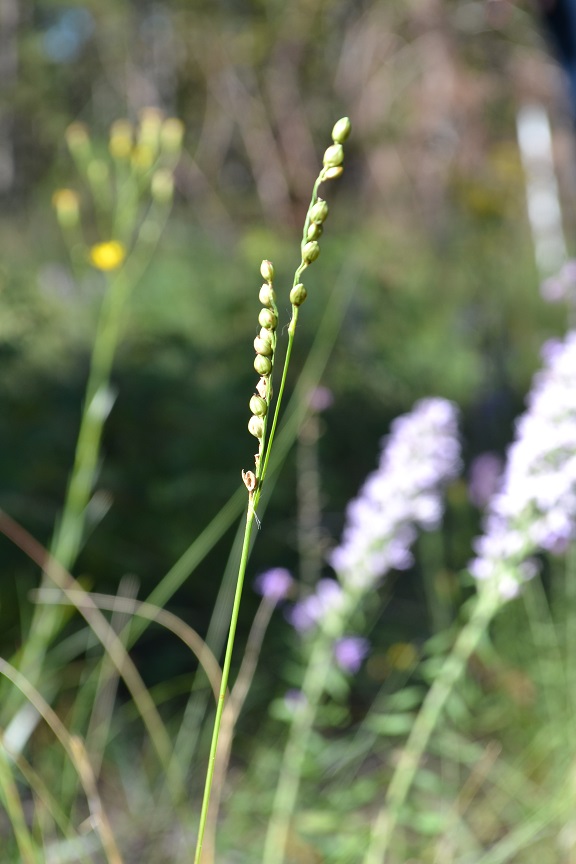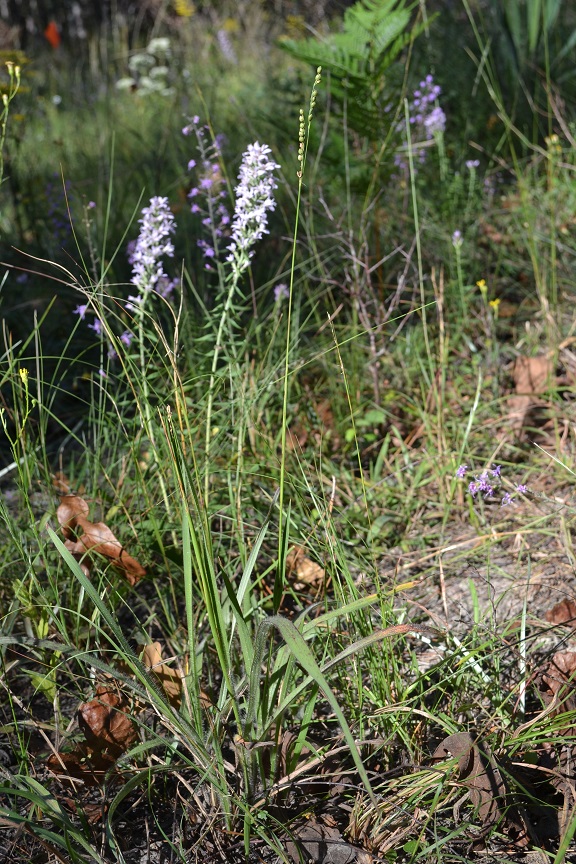Difference between revisions of "Paspalum bifidum"
(→Description) |
(→Distribution) |
||
| (28 intermediate revisions by 12 users not shown) | |||
| Line 3: | Line 3: | ||
{{taxobox | {{taxobox | ||
| name = Paspalum bifidum | | name = Paspalum bifidum | ||
| − | | image = | + | | image = Paspalum bifidum 1.jpg |
| − | | image_caption = | + | | image_caption = Photo taken by Kevin Robertson |
| regnum = Plantae | | regnum = Plantae | ||
| divisio = Magnoliophyta - Flowering plants | | divisio = Magnoliophyta - Flowering plants | ||
| Line 15: | Line 15: | ||
| binomial_authority = (Bertol.) Nash | | binomial_authority = (Bertol.) Nash | ||
| range_map = PASP_BIFI_dist.jpg | | range_map = PASP_BIFI_dist.jpg | ||
| − | | range_map_caption = Natural range of ''Paspalum bifidum'' from USDA NRCS [http:// | + | | range_map_caption = Natural range of ''Paspalum bifidum'' from USDA NRCS [http://plants.usda.gov/core/profile?symbol=PABI3 Plants Database]. |
}} | }} | ||
| + | Common name: pitchfork paspalum, pitchfork crown grass<ref name=weakley>Weakley, A.S. 2020. Flora of the Southeastern United States. Edition of 20 October 2020. University of North Carolina at Chapel Hill, Chapel Hill, North Carolina.</ref> | ||
| + | ==Taxonomic notes== | ||
| + | Synonyms: none<ref name=weakley/> | ||
| + | |||
| + | Varieties: ''Paspalum bifidum'' var. ''bifidum''; ''P. bifidum'' var. ''projectum'' Fernald<ref name=weakley/> | ||
| + | |||
==Description== | ==Description== | ||
<!-- Basic life history facts such as annual/perrenial, monoecious/dioecious, root morphology, seed type, etc. --> | <!-- Basic life history facts such as annual/perrenial, monoecious/dioecious, root morphology, seed type, etc. --> | ||
| − | + | "Annuals or perennials. Leaves primarily basal and low cauline; blade margins usually scaberulous; ligules membranous. Spikelets plano-convex, terminal floret fertile, basal floret sterile. Frist glume usually absent, sterile lemma resembles 2nd glume; fertile lemma and paleas indurate, lustrous, yellowish or brownish. These plants are all important forage grasses."<ref name="Radford et al 1964">Radford, Albert E., Harry E. Ahles, and C. Ritchie Bell. Manual of the Vascular Flora of the Carolinas. 1964, 1968. The University of North Carolina Press. 132-5. Print.</ref> | |
| + | |||
| + | "Perennial form thick rhizome; culms 6-9 dm tall, nodes glabrous or appressed pubescent, internodes glabrous. Blades to 20 cm long, 3-15 mm wide, papillose-pilose to almost glabrous, margins usually ciliate; ligules 2-2.5 mm long. Racemes usually 3, racemose, ascending, 4-9 cm long; rachis triangular, wingless, scaberulous. Spikelets broadly ellipsoid, 3.5-3.8 mm long, basically in 4 rows but by abortion in 2 or 1; pedicels scaberulous angled, 1-3 mm long. Frist legume reduced, rounded, 0.25-0.5 mm long, 2nd glume 7-9 nerved, yellowish brown, glabrous, obtuse, 2.5-3.5 mm long, sterile lemma 5-nerved, yellowish brown, glabrous, obtuse, 3.5-3.8 mm long; fertile lemma and palea lemma nerveless, obtuse, 3.5-3.8 mm long. Grain purplish, broadly ellipsoid, 3 mm long."<ref name="Radford et al 1964"/> | ||
==Distribution== | ==Distribution== | ||
| + | This plant ranges from southeast Virginia to southern Florida, then west to southeast Missouri, southeast Oklahoma, and eastern Texas.<ref name=weakley/> | ||
| + | |||
==Ecology== | ==Ecology== | ||
===Habitat=== <!--Natural communities, human disturbed habitats, topography, hydrology, soils, light, fire regime requirements for removal of competition, etc.--> | ===Habitat=== <!--Natural communities, human disturbed habitats, topography, hydrology, soils, light, fire regime requirements for removal of competition, etc.--> | ||
| − | + | This species can be found growing in longleaf pine-scrub oak sand ridges, sandhills, mixed woodlands, and open longleaf pine forests on rolling terrain.<ref name="FSU Herbarium">Florida State University Robert K. Godfrey Herbarium database. URL: [http://herbarium.bio.fsu.edu http://herbarium.bio.fsu.edu]. Last accessed: June 2014. Collectors: Loran C. Anderson, Robert K. Godfrey, James R. Burkhalter, Bob Lazor,G. Knight, M. Davis, and Robert L. Lazor. States and Counties: Florida: Bay, Escambia, Jackson, Leon, Liberty, Taylor, Wakulla, and Washington. Georgia: Baker and Thomas.</ref> It has been observed in dry loamy sands and moist hummus-rich soils in open areas.<ref name="FSU Herbarium"/> ''P. bifidum'' can also grow in disturbed areas such as along dirt roads and bottomland clearings along rivers.<ref name="FSU Herbarium"/> Associated species include longleaf pine, palmetto, wiregrass, ''Liatris elegans, Quercus laevis, Hypericum gentianoides, Trichostema setacea, Cassia fascicularis, Eupatorium hyssopifolium, Liatris graminifolia, Elephantopus elatus, Agaratina aromatica,'' and ''Helianthus angustifolius.''<ref name="FSU Herbarium"/> | |
| + | |||
===Phenology=== <!--Timing off flowering, fruiting, seed dispersal, and environmental triggers. Cite PanFlora website if appropriate: http://www.gilnelson.com/PanFlora/ --> | ===Phenology=== <!--Timing off flowering, fruiting, seed dispersal, and environmental triggers. Cite PanFlora website if appropriate: http://www.gilnelson.com/PanFlora/ --> | ||
| + | This species flowers from August to October.<ref name="FSU Herbarium"/> | ||
===Seed dispersal=== | ===Seed dispersal=== | ||
| − | ===Seed bank and germination=== | + | This species is thought to be dispersed by gravity.<ref>Kirkman, L. Katherine. Unpublished database of seed dispersal mode of plants found in Coastal Plain longleaf pine-grasslands of the Jones Ecological Research Center, Georgia.</ref> |
| + | <!--===Seed bank and germination===--> | ||
| + | |||
===Fire ecology=== <!--Fire tolerance, fire dependence, adaptive fire responses--> | ===Fire ecology=== <!--Fire tolerance, fire dependence, adaptive fire responses--> | ||
| − | ===Pollination=== | + | Populations of ''Paspalum bifidum'' have been known to persist through repeated annual burns.<ref>Robertson, K.M. Unpublished data collected from Pebble Hill Fire Plots, Pebble Hill Plantation, Thomasville, Georgia.</ref><ref>Platt, W.J., R. Carter, G. Nelson, W. Baker, S. Hermann, J. Kane, L. Anderson, M. Smith, K. Robertson. 2021. Unpublished species list of Wade Tract old-growth longleaf pine savanna, Thomasville, Georgia.</ref> |
| − | === | + | <!--===Pollination===--> |
| − | ===Diseases and parasites=== | + | <!--===Herbivory and toxicology===--> <!--Common herbivores, granivory, insect hosting, poisonous chemicals, allelopathy, etc--> |
| − | ==Conservation and | + | <!--===Diseases and parasites===--> |
| − | == | + | |
| + | ==Conservation, cultivation, and restoration== | ||
| + | |||
| + | ==Cultural use== | ||
==Photo Gallery== | ==Photo Gallery== | ||
| + | <gallery widths=180px> | ||
| + | |||
| + | File:Paspalum bifidum 2.jpg| <center> ''Paspalum bifidum'' <p> Photo by Kevin Robertson </p> | ||
| + | |||
| + | </nowiki></gallery> | ||
| + | |||
==References and notes== | ==References and notes== | ||
| − | |||
Latest revision as of 19:54, 16 June 2023
| Paspalum bifidum | |
|---|---|

| |
| Photo taken by Kevin Robertson | |
| Scientific classification | |
| Kingdom: | Plantae |
| Division: | Magnoliophyta - Flowering plants |
| Class: | Liliopsida – Monocotyledons |
| Order: | Cyperales |
| Family: | Poaceae ⁄ Gramineae |
| Genus: | Paspalum |
| Species: | P. bifidum |
| Binomial name | |
| Paspalum bifidum (Bertol.) Nash | |

| |
| Natural range of Paspalum bifidum from USDA NRCS Plants Database. | |
Common name: pitchfork paspalum, pitchfork crown grass[1]
Contents
Taxonomic notes
Synonyms: none[1]
Varieties: Paspalum bifidum var. bifidum; P. bifidum var. projectum Fernald[1]
Description
"Annuals or perennials. Leaves primarily basal and low cauline; blade margins usually scaberulous; ligules membranous. Spikelets plano-convex, terminal floret fertile, basal floret sterile. Frist glume usually absent, sterile lemma resembles 2nd glume; fertile lemma and paleas indurate, lustrous, yellowish or brownish. These plants are all important forage grasses."[2]
"Perennial form thick rhizome; culms 6-9 dm tall, nodes glabrous or appressed pubescent, internodes glabrous. Blades to 20 cm long, 3-15 mm wide, papillose-pilose to almost glabrous, margins usually ciliate; ligules 2-2.5 mm long. Racemes usually 3, racemose, ascending, 4-9 cm long; rachis triangular, wingless, scaberulous. Spikelets broadly ellipsoid, 3.5-3.8 mm long, basically in 4 rows but by abortion in 2 or 1; pedicels scaberulous angled, 1-3 mm long. Frist legume reduced, rounded, 0.25-0.5 mm long, 2nd glume 7-9 nerved, yellowish brown, glabrous, obtuse, 2.5-3.5 mm long, sterile lemma 5-nerved, yellowish brown, glabrous, obtuse, 3.5-3.8 mm long; fertile lemma and palea lemma nerveless, obtuse, 3.5-3.8 mm long. Grain purplish, broadly ellipsoid, 3 mm long."[2]
Distribution
This plant ranges from southeast Virginia to southern Florida, then west to southeast Missouri, southeast Oklahoma, and eastern Texas.[1]
Ecology
Habitat
This species can be found growing in longleaf pine-scrub oak sand ridges, sandhills, mixed woodlands, and open longleaf pine forests on rolling terrain.[3] It has been observed in dry loamy sands and moist hummus-rich soils in open areas.[3] P. bifidum can also grow in disturbed areas such as along dirt roads and bottomland clearings along rivers.[3] Associated species include longleaf pine, palmetto, wiregrass, Liatris elegans, Quercus laevis, Hypericum gentianoides, Trichostema setacea, Cassia fascicularis, Eupatorium hyssopifolium, Liatris graminifolia, Elephantopus elatus, Agaratina aromatica, and Helianthus angustifolius.[3]
Phenology
This species flowers from August to October.[3]
Seed dispersal
This species is thought to be dispersed by gravity.[4]
Fire ecology
Populations of Paspalum bifidum have been known to persist through repeated annual burns.[5][6]
Conservation, cultivation, and restoration
Cultural use
Photo Gallery
References and notes
- ↑ 1.0 1.1 1.2 1.3 Weakley, A.S. 2020. Flora of the Southeastern United States. Edition of 20 October 2020. University of North Carolina at Chapel Hill, Chapel Hill, North Carolina.
- ↑ 2.0 2.1 Radford, Albert E., Harry E. Ahles, and C. Ritchie Bell. Manual of the Vascular Flora of the Carolinas. 1964, 1968. The University of North Carolina Press. 132-5. Print.
- ↑ 3.0 3.1 3.2 3.3 3.4 Florida State University Robert K. Godfrey Herbarium database. URL: http://herbarium.bio.fsu.edu. Last accessed: June 2014. Collectors: Loran C. Anderson, Robert K. Godfrey, James R. Burkhalter, Bob Lazor,G. Knight, M. Davis, and Robert L. Lazor. States and Counties: Florida: Bay, Escambia, Jackson, Leon, Liberty, Taylor, Wakulla, and Washington. Georgia: Baker and Thomas.
- ↑ Kirkman, L. Katherine. Unpublished database of seed dispersal mode of plants found in Coastal Plain longleaf pine-grasslands of the Jones Ecological Research Center, Georgia.
- ↑ Robertson, K.M. Unpublished data collected from Pebble Hill Fire Plots, Pebble Hill Plantation, Thomasville, Georgia.
- ↑ Platt, W.J., R. Carter, G. Nelson, W. Baker, S. Hermann, J. Kane, L. Anderson, M. Smith, K. Robertson. 2021. Unpublished species list of Wade Tract old-growth longleaf pine savanna, Thomasville, Georgia.
